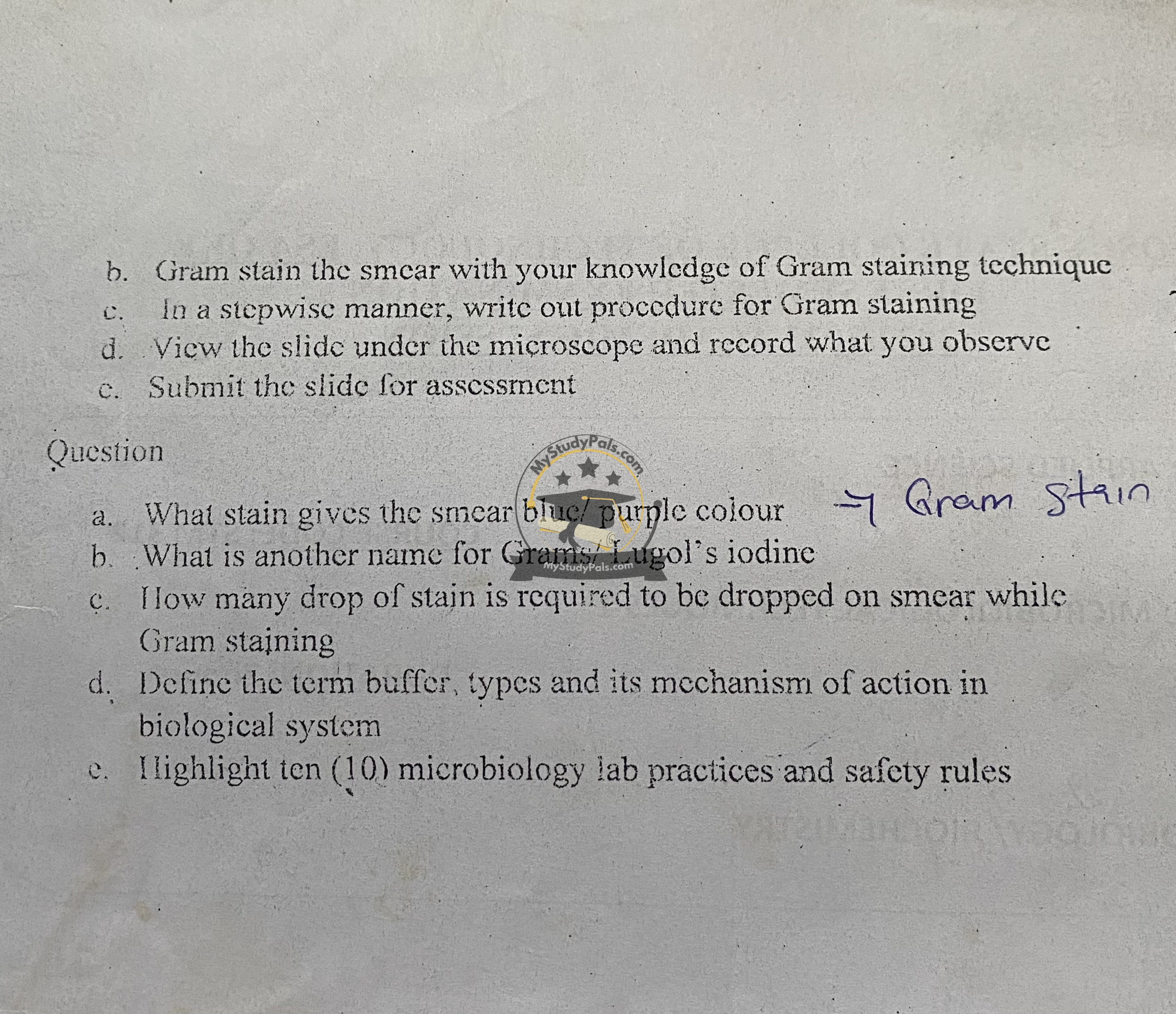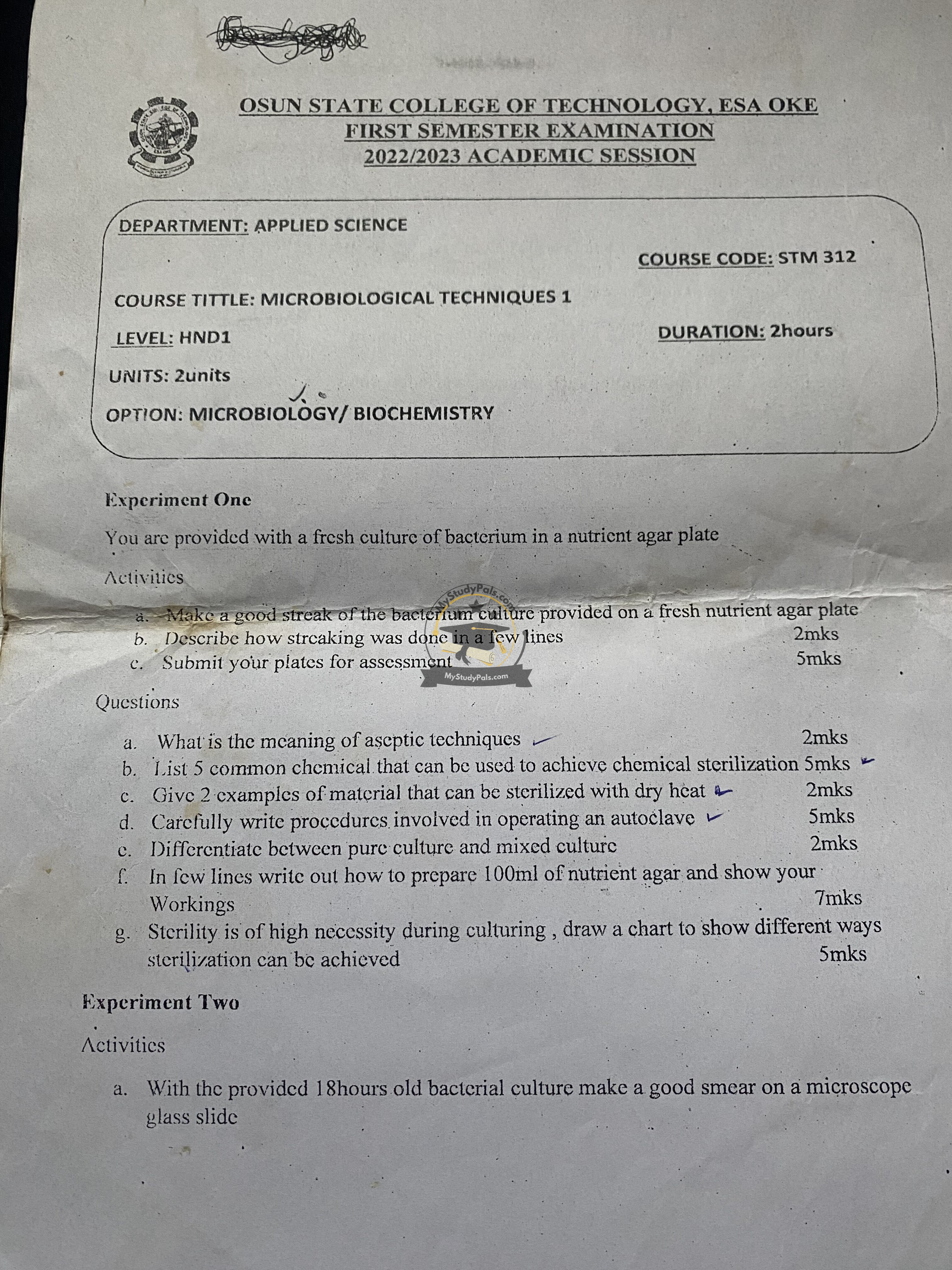ANWSER
Question 1:
Answer: Aseptic techniques refer to practices and procedures that prevent contamination of cultures, sterile media, and equipment by microorganisms. These techniques include sterilization, disinfection, and proper handling of materials in a microbiology lab.
Question 2:
Answer: Five common chemicals used for chemical sterilization include:
- Ethanol (70%)
- Hydrogen peroxide
- Glutaraldehyde
- Formaldehyde
- Sodium hypochlorite (bleach)
Question 3:
Answer: Two examples of materials that can be sterilized using dry heat are:
- Glassware (e.g., test tubes, Petri dishes)
- Metal instruments (e.g., forceps, scalpels)
Question 4:
Answer: Procedures involved in operating an autoclave:
- Load the materials into the autoclave, ensuring proper spacing for steam penetration.
- Add water to generate steam.
- Set the autoclave to 121°C at 15 psi for 15–20 minutes.
- Allow the pressure to release before opening the autoclave.
- Carefully remove sterilized materials using aseptic techniques.
Question 5:
Answer: Differences between pure culture and mixed culture:
- Pure Culture: Contains only one type of microorganism.
- Mixed Culture: Contains two or more different microorganisms.
Question 6:
Answer: Preparation of 100 mL of nutrient agar:
- Weigh 2.8 g of nutrient agar powder.
- Dissolve in 100 mL of distilled water.
- Heat to dissolve completely.
- Autoclave at 121°C for 15 minutes.
- Cool slightly and pour into sterile Petri dishes.
Question 7:
Answer: Sterilization methods and chart representation:
| Method | Example |
|---|---|
| Heat Sterilization | Autoclaving (moist heat) |
| Dry Heat Sterilization | Hot air oven |
| Chemical Sterilization | Ethanol, formaldehyde |
| Filtration | Membrane filtration for heat-sensitive liquids |
| Radiation | UV light, gamma radiation |
Experiment Two
Question 8:
Answer: To make a bacterial smear on a microscope slide:
- Place a drop of distilled water on a clean slide.
- Use a sterile loop to collect bacteria and mix with water.
- Spread into a thin layer.
- Air dry and heat-fix by passing over a flame.
Question 9:
Answer: Gram staining procedure:
- Apply crystal violet (primary stain) for 1 minute, then rinse.
- Apply iodine (mordant) for 1 minute, then rinse.
- Decolorize with ethanol or acetone for 10–15 seconds, then rinse.
- Apply safranin (counterstain) for 1 minute, then rinse and dry.
Question 10:
Answer: The stain that gives a smear a blue/purple color is Gram stain (crystal violet).
Question 11:
Answer: Another name for Gram’s/Lugol’s iodine is Mordant.
Question 12:
Answer: Generally, 2–3 drops of stain are required for Gram staining.
Question 13:
Answer: Buffer definition: A buffer is a solution that resists changes in pH when an acid or base is added.
- Types:
- Acidic buffer (e.g., Acetic acid + Sodium acetate)
- Basic buffer (e.g., Ammonia + Ammonium chloride)
- Mechanism: Buffers maintain pH by absorbing excess H+ or OH⁻ ions.
Question 14:
Answer: Ten microbiology lab practices and safety rules:
- Wash hands before and after lab work.
- Disinfect work surfaces before and after use.
- Wear appropriate personal protective equipment (PPE).
- Work near a Bunsen burner for aseptic techniques.
- Avoid eating or drinking in the lab.
- Properly label all cultures and chemicals.
- Dispose of biological waste properly.
- Always sterilize inoculating loops before and after use.
- Do not pipette by mouth.
- Report spills and accidents immediately.



